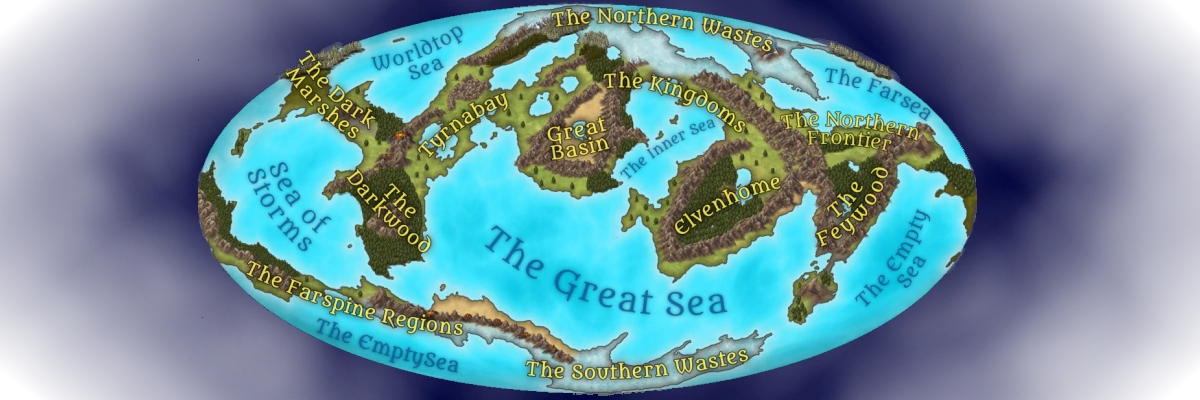The Dwarven Clan Dagger
There are two things that every creature on Cartyrion that identifies itself as Dwarven possesses, and would rather die than part with willingly. The first is their beard - the facial hair that every Dwarf - male or female - is fiercly proud of. When formally groommed, its braids and gathers will identify familial and occupational relationships of its owner. But beards can become disheveled, and sometimes may need to be covered as a Dwarf goes about its business. The second item, is a possession presented to a Dwarf at birth, and carried by that Dwarf from the day of their first coming-of-age ceremony until their dying day. This item is an integral part of their identity as a Dwarf... it is their Clan Dagger.
Dwarves, like every other race of Folk on Cartyrion, have good and bad among their numbers. Dwarves are just as likely to be encountered as highway bandits, brigands, or pirates as any other race - and just as likely to potentially target other Dwarves in their illicit pursuits. But Dwarven culture placed great importance on Clan unity. One of the most significant crimes a Dwarf can commit is to willingly cause - or even allow - harm to be done to another Dwarf of the same Clan.
Item Name
Dwarven Clan Dagger
The blade is of adamantite steel, two-edged, between 1in and 2in (2cm and 5cm) in width and approximately 10in (25cm) long. It may be straight or curved. It may also be etched or inlaid with patterns associated with the family of its possessor.
Most do not have a crosspiece between blade and grip. On those that do, the crosspiece is minimal.
There is never a pronounced pommel.
the grip and sheath are decorated to such that the sheathed blade resembles a single decorative item. Grip and sheath can be made of a number of materials including bone, ivory, marble, jade, turquoise, bloodstone, moonstone, ironwood, mahogany or other hardwood. Porcelain has been used on occasion. There have been a few known examples of carved obsidian grips as well. Gold and silver have been used in the past for members of the ruling families of the Delves.
Stories abound of Dwarven travelers being stopped on a remote road by Dwarven brigands, or of Dwarven sea captains being chased down by Dwarven pirates - only to be allowed to continue on their way unabused when they discover they are of the same clan.
Description
A Dwarven Clan Dagger is a weapon with a two-edged blade, and is always crafted with a sheath that matches the grip of the weapon itself such that, when worn, gives the appearance that blade and sheath are a single decorative item. (Dimensions and other crafting details are provided in the sidebar.) Much - but not all - of the decoration of grip and sheath, including the ancient runes that are invariably present, identify the owner of the weapon as being a member of one of the Twelve Dwarven Clans, but beyond the key identifying marks, much leeway remains to ensure that every dagger is unique.Significance
When the first Dwarves were Awakened by the Duagnar deities Berdea and Atezana, they were formed into twelve Clans, each consisting of six Clan Mothers and six Clan Fathers. Since that time, every Dwarf that has been born and raised as a Dwarf is taught their ancestral lineage back to these to identify the Clan to which they belong. (Over the years, complex rules in Dwarven society have developed to deal with inevitable situations where Dwarves from two different clans marry and produce offspring.) The intricate decorations placed on a Clan Dagger given to a newborn Dwarf will indicate that clan. No matter how ornate the carvings and etchings may be, those who know what to look for can identify a Dwarf's clan simply by "reading" the dagger.Practical Protection
Despite its primary purpose as being a means of identifying a Dwarf's Clan, the dagger is a functional weapon. Dwarves are trained from childhood in techniques of using their Clan Daggers as weapons of last resort should self-defense require it. But this is not the only way a Clan Dagger can offer protection to its owner.Dwarves, like every other race of Folk on Cartyrion, have good and bad among their numbers. Dwarves are just as likely to be encountered as highway bandits, brigands, or pirates as any other race - and just as likely to potentially target other Dwarves in their illicit pursuits. But Dwarven culture placed great importance on Clan unity. One of the most significant crimes a Dwarf can commit is to willingly cause - or even allow - harm to be done to another Dwarf of the same Clan.
Construction
Stories abound of Dwarven travelers being stopped on a remote road by Dwarven brigands, or of Dwarven sea captains being chased down by Dwarven pirates - only to be allowed to continue on their way unabused when they discover they are of the same clan.



Comments